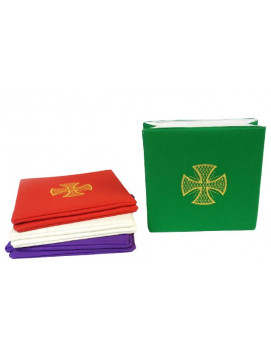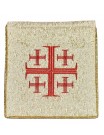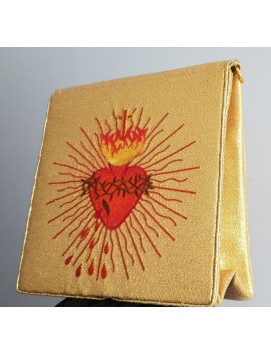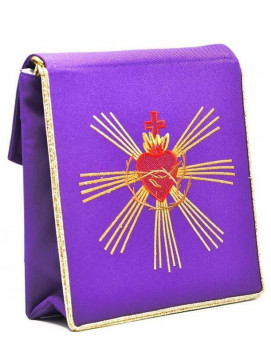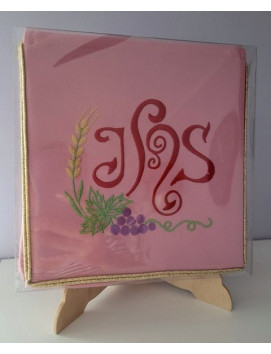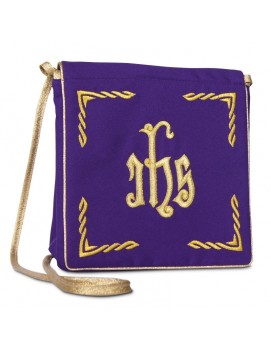No products
Burses
A Catholic burse is a receptacle used to carry the folded corporal to and from the altar for reasons of convenience and reverence. It is a parament about twelve inches square and is made of two juxtaposed pieces of cardboard bound together at three edges, leaving the fourth open to receive the corporal. One outer side of the burse is of the same material and color as the vestments with which it is used, while the rest is lined with linen or silk. The use of the burse is relatively recent, and it is uncertain when this custom began. The burse is used in the liturgy of the Roman Catholic Church and the Lutheran churches. Until the reform of the Second Vatican Council, the burse was carried by the priest to the altar when he entered for Holy Mass. It was placed upon the chalice at the beginning and end of the Mass and on the altar at benediction. The burse is a symbol of the reverence and respect given to the corporal, which is the white linen cloth upon which the chalice and paten are placed during the celebration of the Eucharist. Burse can be purchased from various online retailers, and can be custom-made to fit the clergy member's style and preferences.
A Catholic burse is a receptacle used to carry the folded corporal to and from the altar for reasons of convenience and reverence. It is a parament about twelve inches square and is made of two juxtaposed pieces of cardboard bound together at three edges, leaving the fourth open to receive the corporal. One outer side of the burse is of the same material and color as the vestments with which it is used, while the rest is lined with linen or silk. The use of the burse is relatively recent, and it is uncertain when this custom began. The burse is used in the liturgy of the Roman Catholic Church and the Lutheran churches. Until the reform of the Second Vatican Council, the burse was carried by the priest to the altar when he entered for Holy Mass. It was placed upon the chalice at the beginning and end of the Mass and on the altar at benediction. The burse is a symbol of the reverence and respect given to the corporal, which is the white linen cloth upon which the chalice and paten are placed during the celebration of the Eucharist. Burse can be purchased from various online retailers, and can be custom-made to fit the clergy member's style and preferences.
The Catholic Burse: A Symbol of Reverence and Tradition
The Catholic burse holds a special place in the liturgical practices of the Catholic Church, embodying both reverence and tradition. This comprehensive article delves into the fascinating world of the Catholic burse, exploring its history, significance, and the various forms it takes within the Church's rituals.
What is a Catholic Burse?
A Catholic burse is essentially a flat, square container used to carry and protect the corporal, a sacred linen cloth, to and from the altar. The corporal itself holds great significance, as it is used during the celebration of the Eucharist to bear the chalice and paten, which in turn hold the Body and Blood of Christ. The burse, typically about twelve inches square, is made of two stiff pieces of material, often beautifully adorned to match the liturgical vestments.
The Historical Journey of the Burse
The use of the burse is relatively recent in the long history of Catholic liturgical practices. It emerged when the corporal, which had been large in earlier times, was reduced in size. This change necessitated a new method for safely transporting the corporal to and from the altar, leading to the creation of the burse. Originating probably at Rheims, the use of the burse gradually spread throughout Europe during the 11th century.
The Burse in Liturgical Use
During Mass, the burse is carried with the folded corporal inside it, placed on top of the veiled chalice. It is also used for Communion outside of Mass and for Benediction, highlighting its versatility and importance in various liturgical contexts. The burse is not only a practical item but also a symbol of the reverence and respect given to the corporal and, by extension, to the Eucharist itself.
Variations and Modern Usage
While the traditional burse is used to carry the corporal, the term "burse" also refers to a small bag, often made of leather or another durable material, used to transport the pyx containing the Blessed Sacrament when bringing Communion to the sick. This highlights the adaptability of the burse to meet the needs of the Church and its members in different circumstances.
The Significance of the Burse
The Catholic burse, through its design and use, serves as a poignant reminder of the Church's dedication to preserving the sanctity of the Eucharist. It underscores the importance of treating the sacred elements with the utmost care and reverence, a principle that has guided Catholic liturgical practices for centuries.
FAQs
Q: Can anyone use a Catholic burse?
A: The use of a Catholic burse is typically reserved for clergy members during the performance of liturgical duties.
Q: Are there different designs for a Catholic burse?
A: Yes, burses can vary in design, often to match the liturgical vestments. They can be adorned with symbols, embroidery, and come in colors corresponding to the liturgical season.
Q: How is a burse made?
A: A burse is made of two stiff pieces of material, usually cardboard, covered with fabric that matches the liturgical vestments. It is hinged on one side to allow the corporal to be placed inside.
Q: Why is the burse important?
A: The burse symbolizes the Church's reverence for the Eucharist. By providing a dignified way to transport the corporal, the burse reflects the care and respect afforded to the Body and Blood of Christ.
In conclusion, the Catholic burse is more than just a practical item used in the liturgy. It is a symbol of tradition, reverence, and the deep respect the Catholic Church holds for the Eucharist. Through its careful design and use, the burse embodies the sacredness of the liturgical practices and serves as a reminder of the Church's commitment to honoring the presence of Christ in the Eucharist.




